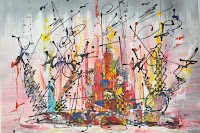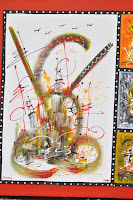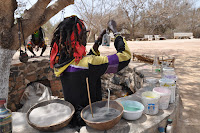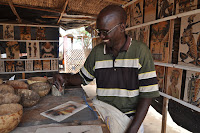The Chapel I visited afterwards bears the name of its patron Saint, the Italian reformer Archbishop and Cardinal, Charles Borromée.
The old chuch which stood wher the chapel stands now is said to have been burnt down by soldiers on the eve of Christmas in 1799 during the attack carried out by the Bristish who took over the island.
Catholic followers having been deprived of their church grounds are said to have gathered temporarily at one of the Signares' of Gorée - Anna Colas Pépin for mess, wedding and baptismal ceremonies until the reconstruction of the church in 1830.
Spiral stairs made in wrough iron at the French Marine "ateliers"
It was quite an interesting little church I thought.
We then continued onto le Castel, having had to climb up to the highest point of the island along a baobad lined road where many local artists, from painters to jewellery makers were expossing their handicraft works. We stopped several times to talk to them, in particular a painter. I ended up buying two rather unique necklaces.
Pape Diallo next to his paintings
The ship shaped memorial could be seen right at the centre of square, whose edges were filled with little Art stalls of all sorts.
We stopped to talk to an artist who works with coloured sand. Having travelled the world in search of different techniques he took the time to explain some of his artistry "secrets" to me. I couldn't resist buying him a sand coloured bottle with a rather exquisite design.
We strolled around looking at the desactivated cannon, admiring the view and the Dakar skyline.
On the way down we stopped at an atellier of a artist who makes sand paintings and once more I was taught some of the used techniques.
As we started making our way down I sighted a painted mural I believed to be associated with Baye Fall and the Mouride Bortherhood movement in West Africa or Cheikh Ahmadou Bamba Mbacké but I completely forgot to ask Aly about it as I now wonder whether the impact either of them has had in Senegal.
(To be continued)












































No comments:
Post a Comment